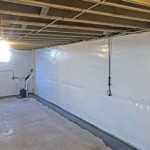Insulating Basement Walls With Fiberglass: A Step-by-Step Guide
If you're looking to make your basement more comfortable and energy-efficient, insulating the walls with fiberglass is an effective and affordable solution. Fiberglass is a type of insulation made from tiny glass fibers that trap air and prevent heat transfer. This makes it an excellent choice for insulating basement walls, as it can help to keep your basement warm in the winter and cool in the summer.
Installing fiberglass insulation in your basement walls is a relatively easy DIY project that can be completed in a weekend. Here's a step-by-step guide to help you get started:
1. Gather Your Materials
Before you begin, you'll need to gather the following materials:
- Fiberglass insulation batts
- Insulation adhesive
- Utility knife
- Measuring tape
- Safety glasses
- Dust mask
2. Prepare the Walls
Before you can install the insulation, you need to prepare the walls. This involves removing any dust or debris from the walls and making sure that the surface is smooth and even. If there are any holes or cracks in the walls, you should fill them with caulk or expanding foam.
3. Cut the Insulation
Once the walls are prepared, you can begin cutting the insulation. Measure the height and width of each wall and cut the insulation batts to fit. Be sure to cut the batts slightly larger than the actual measurement, as this will help to ensure a snug fit.
4. Apply the Insulation
Once the batts are cut, you can begin applying them to the walls. Start by applying a thin layer of insulation adhesive to the back of each batt. Then, press the batt into place on the wall. Be sure to press firmly to ensure a good bond.
5. Repeat
Continue applying insulation batts to the walls until all of the walls are covered. Be sure to stagger the joints between the batts to minimize air leaks.
6. Cover the Insulation
Once the insulation is installed, you need to cover it with a vapor barrier. This will help to prevent moisture from getting into the insulation and causing it to lose its effectiveness. You can use a plastic vapor barrier or a foil-faced vapor barrier. Simply staple the vapor barrier to the walls, overlapping the seams by at least 6 inches.
7. Finish Up
Once the vapor barrier is installed, you're finished! You can now enjoy a more comfortable and energy-efficient basement.
Tips
Here are a few tips to help you get the best results when insulating your basement walls with fiberglass:
- Wear safety glasses and a dust mask when working with fiberglass. Fiberglass fibers can be irritating to the skin and lungs.
- Use a utility knife with a sharp blade to cut the insulation. A dull blade will cause the insulation to tear.
- Be sure to cut the insulation batts slightly larger than the actual measurement. This will help to ensure a snug fit.
- Press the insulation batts firmly into place on the walls. This will help to ensure a good bond.
- Stagger the joints between the insulation batts to minimize air leaks.
- Cover the insulation with a vapor barrier to prevent moisture from getting into the insulation.

Insulating Basement Walls With Fiberglass Batting Semigloss Design

Insulating Basement Walls With Fiberglass Batting Semigloss Design

Insulating Basement Walls With Fiberglass Batting Semigloss Design

How To Insulate Basement Walls True Value

Etw Foundation R 13 Fiberglass Batt In A 2x4 Framed Wall Buildingscience Com

Three Ways To Insulate A Basement Wall Fine Homebuilding

Etw Foundation 2 Xps 2x4 Framing With Fiberglass Batt Buildingscience Com

Basement Wall Insulation Knauf

Basement Blanket Insulation Building America Solution Center

Basement Blanket Insulation Building America Solution Center








